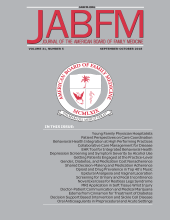Article Figures & Data
Tables
Characteristics Patients (n = 45) Age (years), mean (SD) 57 (13) Female sex 22 (49) Race/ethnicity White 40 (89) Hispanic 3 (7) Other 4 (9) Native American 1 (2) Pain indication* Unspecified joint pain 30 (67) Neuropathy 17 (38) Unspecified back pain 15 (33) Unspecified muscle pain 11 (24) Unspecified pain 11 (24) Osteoarthritis 10 (22) Spinal disease or pain 9 (20) Unspecified neck pain 7 (16) Fibromyalgia 3 (7) Migraine 2 (4) Rheumatoid arthritis 2 (4) Other 8 (18) Comorbidities* Tobacco use 28 (62) Anxiety 27 (60) Depression 25 (56) Insomnia 20 (44) Alcohol use 18 (42) Migraines 9 (20) History of illicit drug use 5 (11) Bipolar 3 (7) Other psychiatric condition 2 (4) Data are n (%) unless otherwise indicated.
↵* Characteristics are not mutually exclusive. Patients may have multiple documented indications and comorbidities.
SD, standard deviation.
Outcomes Before Intervention (n = 45) After Intervention (n = 45) P Value MMEs/day Based on prescription directions 151 (110) 125 (114) <.001 Based on number of pills prescribed per month 135 (100) 116 (106) <.001 Pain scores* 5.3 (2.6) 5.5 (2.5) .783 Data are mean (standard deviation) unless otherwise indicated.
↵* Only patients with data available before and after the intervention were included in analysis of this outcome (n = 27).
MME, morphine milligram equivalent.
Outcomes Before Intervention (n = 45) After Intervention (n = 45) P Value Patients concurrently taking high-risk medications Benzodiazepines 21 (47) 14 (31) .008 Hypnotics 10 (22) 7 (16) .083 Muscle relaxants 8 (18) 10 (22) .157 Nonopioid analgesics prescribed, mean (SD) 2.1 (1.3) 2.4 (1.4) .002 Opioid analgesics prescribed, mean (SD) 1.6 (0.6) 1.5 (0.7) .219 Offered outpatient naloxone prescription 6 (13) 22 (49) .009 Current urine drug screen* 15 (33) 27 (60) <.001 Current review of the state's PDMP† 12 (27) 26 (58) <.001 Referral to pain specialist 17 (38) 21 (47) .046 Referral to physical therapy 33 (73) 34 (76) .317 Patients prescribed a bowel regimen 6 (13) 22 (49) <.001 Outcomes Value Pharmacist Total reviews provided, n 80 Reviews per patient 1.8 (0.9) Minutes required for review 33 (19) Pharmacist recommendations Total recommendations provided, n 301 Total recommendations implemented, n (% of total recommendations provided) 114 (38) Provided per patient 6.3 (1.5) Implemented per patient 2.5 (1.3) Provider Total appointments, n 118 Appointments per patient 2.6 (1.3) Data are mean (standard deviation) unless otherwise indicated.
Opioid Equivalent Milligram (mg) Codeine, oral 200 Fentanyl, transdermal 12.5 Hydrocodone, oral 30 Hydromorphone, oral 7.5 Hydromorphone, parenteral 1.5 Methadone, oral (1 to 20 mg/day) 7.5 Methadone, oral (21 to 40 mg/day) 3.75 Methadone, oral (41 to 60 mg/day) 3 Methadone, oral (61+ mg/day) 2.5 Morphine, oral 30 Morphine, parenteral 10 Oxycodone, oral 20 Oxymorphone, oral 10 Oxymorphone, parenteral 1 Tramadol, oral 120 Select Recommendations Given to Provider, n (% of patients) Implemented, n (% of specific recommendation) Initiate/change non-opioid analgesic regimen 45 (100) 22 (49) Consider opioid taper 43 (96) 22 (51) Refer to pain specialist 42 (93) 5 (12) Offer outpatient naloxone prescription 37 (82) 20 (54) Review state's PDMP 35 (78) 15 (43) Obtain urine drug screen 31 (69) 16 (52) Taper/discontinue concurrent high-risk medications 20 (44) 8 (40) PDMP, prescription drug monitoring program.






